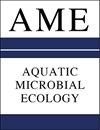Insights into the planktonic to sessile transition in a marine biofilm-forming Pseudoalteromonas isolate using comparative proteomic analysis
IF 1.1
4区 环境科学与生态学
Q3 ECOLOGY
引用次数: 3
Abstract
Bacterial biofilms play an important role in marine biofouling. The formation of a biofilm starts when marine bacterial cells transition from a planktonic to an attached state. However, the molecular mechanisms involved in this transition are poorly understood. Here, 51 strains of marine bacteria were isolated from natural biofilms growing on submerged artificial surfaces (glass slides, epoxy panels, and bridge pillars) and evaluated for their biofilm-forming capacity. Eleven strains formed relatively strong biofilms and 16S rRNA gene sequence analysis indicated that they belonged to the genera Leisingera, Roseobacter, Pseudoalteromonas, Alteromonas, Tenacibaculum, Vibrio, Chryseobacterium, Aquimarina, and Acinetobacter. Strain Pseudoalteromonas sp. W-7 showed efficient and rapid attachment and was therefore chosen for further study. An iTRAQ-based comparative proteomic analysis of planktonic and attached strain W-7 cells was carried out. A total of 3468 proteins were identified, of which 163 showed significant differential expression (120 down-regulated and 43 up-regulated in attached cells relative to planktonic cells). KEGG (Kyoto encyclopedia of genes and genomes) analysis indicated that pyruvate metabolism, carbon fixation, and carbon metabolism were significantly affected in attached cells. Up-regulated proteins such as UTP-glucose-1-phosphate uridylyltransferase, acetyltransferase component of pyruvate dehydrogenase complex, OmpA-like protein, and acetyl-coenzyme A synthetase may be important during initial adhesion. Our findings provide a deeper understanding of the planktonic to sessile transition of marine fouling bacteria.利用比较蛋白质组学分析了解海洋生物膜形成假互生单胞菌从浮游到无根的转变
细菌生物膜在海洋生物污染中起着重要的作用。当海洋细菌细胞从浮游状态转变为附着状态时,生物膜的形成开始了。然而,参与这一转变的分子机制尚不清楚。在这里,51株海洋细菌从生长在水下人工表面(玻璃片、环氧树脂板和桥柱)的天然生物膜中分离出来,并评估了它们的生物膜形成能力。11株菌株形成了较强的生物膜,16S rRNA基因序列分析表明它们属于Leisingera、Roseobacter、Pseudoalteromonas、Alteromonas、Tenacibaculum、Vibrio、Chryseobacterium、Aquimarina和Acinetobacter。菌株假交替单胞菌sp. W-7具有高效、快速的附着效果,因此被选为进一步研究的对象。利用itraq对浮游和附着菌株W-7细胞进行了比较蛋白质组学分析。共鉴定出3468个蛋白,其中163个蛋白与浮游细胞有显著差异表达(120个蛋白在附着细胞中下调,43个蛋白在附着细胞中上调)。KEGG(京都基因和基因组百科全书)分析表明,在附着细胞中丙酮酸代谢、碳固定和碳代谢受到显著影响。上调的蛋白如utp -葡萄糖-1-磷酸尿苷基转移酶、丙酮酸脱氢酶复合物乙酰基转移酶组分、ompa样蛋白和乙酰辅酶A合成酶可能在初始粘附过程中起重要作用。我们的发现为海洋污染细菌从浮游到无根的转变提供了更深入的理解。
本文章由计算机程序翻译,如有差异,请以英文原文为准。
求助全文
约1分钟内获得全文
求助全文
来源期刊

Aquatic Microbial Ecology
环境科学-海洋与淡水生物学
CiteScore
3.30
自引率
0.00%
发文量
8
审稿时长
3.0 months
期刊介绍:
AME is international and interdisciplinary. It presents rigorously refereed and carefully selected Research Articles, Reviews and Notes, as well as Comments/Reply Comments (for details see AME 27:209), Opinion Pieces (previously called ''As I See It'') and AME Specials. For details consult the Guidelines for Authors. Papers may be concerned with:
Tolerances and responses of microorganisms to variations in abiotic and biotic components of their environment; microbial life under extreme environmental conditions (climate, temperature, pressure, osmolarity, redox, etc.).
Role of aquatic microorganisms in the production, transformation and decomposition of organic matter; flow patterns of energy and matter as these pass through microorganisms; population dynamics; trophic interrelationships; modelling, both theoretical and via computer simulation, of individual microorganisms and microbial populations; biodiversity.
Absorption and transformation of inorganic material; synthesis and transformation of organic material (autotrophic and heterotrophic); non-genetic and genetic adaptation; behaviour; molecular microbial ecology; symbioses.
 求助内容:
求助内容: 应助结果提醒方式:
应助结果提醒方式:


